At OrthoSmile, our orthodontist team combine high educational credentials with exceptional rapport to make getting braces a pleasant experience. Our expertise includes all types of braces, including Invisalign braces, ceramic braces, lingual braces, clear braces, adult braces and combined orthodontic-orthognatic jaw surgery.
Whether you are an adult seeking professional results or the parent of a child who needs a specialized and gentle orthodontic treatment and expects superior orthodontic care. Our orthodontist team also stay current with the latest orthodontic techniques to straighten teeth as quickly and effectively as possible. Please visit us "OrthoSmile Dental Clinic".
Braces are a device that is used to straighten teeth, to correct a bite and to correct irregular teeth. Teeth respond to the gentle forces that are applied to them. Modern orthodontists have devised many different types of dental braces to effectively take care of shaky teeth or to align them properly.
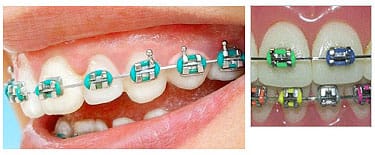
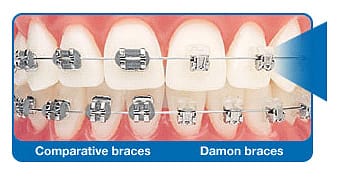
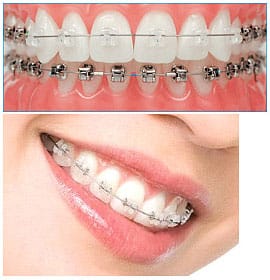
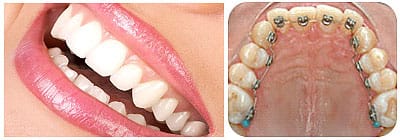
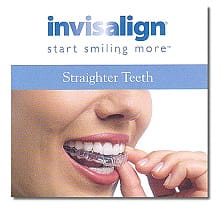
To ensure the best overall facial and dental development, children should have an orthodontic consultation by the time they reach age 7, according to the American Association of Orthodontists. If a problem is evident at a younger age, then seek an orthodontic evaluation sooner. This evaluation typically is just for observation and we will continue to monitor progress at no charge. If a problem is evident, taking action early can spare a lot of treatment and expense in the future.
It is a common misconception that braces are for children and teenagers, but anyone- regardless of age- can benefit from orthodontic treatment, whether it is catching developmental problems early in children or correcting a long-standing bite problem that did not get addressed in younger years.
It is never too late to achieve a beautiful smile. If you've been hiding your smile or living with a bite problem for a long time, it's time you learned how adult orthodontics can transform your smile and your life. There is no age limit to improving your smile and self-esteem. Adults of any age can enjoy the benefits of orthodontic treatment with Invisalign - a series of removable, clear plastic aligners; Damon System Braces or iBraces (lingual braces, hidden braces or invisible braces).
Maybe you didn't get braces when you needed them as a child, or maybe you did, but you stopped wearing your retainer. Orthodontics can still help you. You are never too old for a beautiful smile.
Smiles are a big part of our identity, how we feel about ourselves and how others perceive us. Many people said that crooked teeth leave a negative first impression. It's easier than ever before to improve your smile in far less time, with greater comfort and with greater results and benefits that last a lifetime. A nice smile is not only beautiful, it also promotes good health.
porthodontic treatment gives people a lot to be happy about. Let our expertise make you smile. When left untreated, many minor orthodontic problems may become worse, contributing to abnormal wear of tooth surfaces, inefficient chewing, excessive gum stress on gum tissue, and misalignment of the jaw joints. This can all lead to chronic headaches or pain in the face or neck. Treatment by a specialist to correct minor orthodontic issues are often less costly than the additional dental care required to treat more serious problems that can develop in later years.
So, no matter what age you are it is never too early or too late to invest in braces and ultimately invest in yourself. Start enjoying the lifelong results today.
Orthodontics is a branch of Dentistry specializing in diagnosis, prevention and treatment of jaw, face and bite irregularities (malocclusion). Orthodontic treatment is provided by an oral health care professional known as an Orthodontist. Recent years have brought about many changes within the dental industry, specifically with regards orthodontic treatment and care. Now more than ever patients are experiencing fewer incidences of cavities and missing teeth due to the heighten awareness of fluoride use and preventive dentistry. This increasing awareness on the health and look of a patient’s smile has fueled the desire for many to seek out orthodontic treatment not only as a medical necessity, but for cosmetic reason as well.
Whether it is traditional braces, or custom made removable appliances, Orthodontics can help you have the healthy, straight and beautiful smile you’ve been waiting for!
Coming Soon
People of all ages can be good ortho candidates but dentist or orthodontist can determine whether you can benefit from orthodontics. Based on diagnostic tools that include a full medical and dental health history, a clinical exam, impression for models of your teeth, bite registration, special X-rays and photographs, an orthodontist develop a treatment plan that’s right for you. Many people think that braces are only for straightening teeth. On the contrary, braces can also be used to realign teeth, correct a person’s bite and correct problems with a person’s jaw. There are a number of common teeth problems that could lead to a person needing braces. If you have any of the following, you may be a candidate for orthodontic treatment
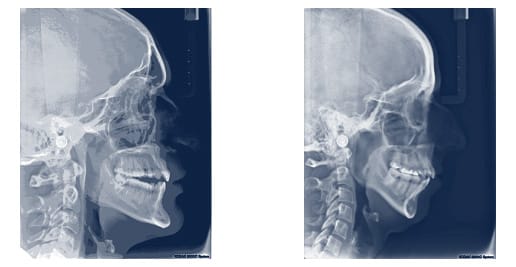
People who have skeletal problems, vertical deformities of the long face and short face types, excessive incisors protrusion or lip strain need treatment as soon as they are discovered, typically during the early mixed dentition. By the braces or/and surgery, you can improve your facial appearance. Orthodontic treatment will make your smile look fabulous. The fabulous smile will last for the rest of your life. Think about how a fabulous smile will improve your life. Orthodontic treatment will also make your face look delightful. Wouldn't a delightful face be wonderful?

This occurs with abnormal continued growth of the jaw bone and discrepancy of tooth size. When teeth are missing, this can also be caused by the surrounding teeth shifting due to extra space. Spacing issues between teeth can lead to gum problems (due to lack of protection by the teeth), periodontal pockets and increased risk of periodontal disease. Sometimes people say they have trouble with biting and chewing correctly. Space problems are most often corrected with braces.
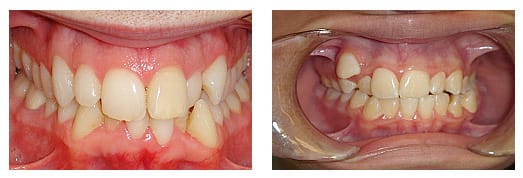
This occurs when there is simply a lack of room within your jaw for all of your teeth to fit normally. Because the dental arch is too small, the teeth move together until there is nowhere left to move but up or down. When left untreated, overly crowded teeth can get worse over time. This crowding can lead to plaque accumulation, tooth decay and an increased chance of gum disease as well as his or her appearance. Often crowded teeth can be corrected with some teeth extractions as well as braces, to move everything into proper position

This occurs when the upper and lower jaws are both misaligned. It causes one or more upper teeth to bite on the inside of the lower teeth, and can happen on both the front and the sides of the mouth. This can lead to abnormal tooth wear and chipping, chewing problem and periodontal problems including gum disease and bone loss.
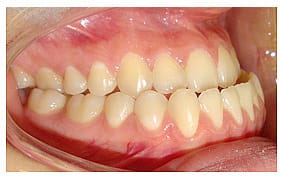
This occurs when the lower teeth protrude past the front teeth. It’s usually caused by undergrowth of the upper jaw, overgrowth of the lower jaw, or both. It can also be caused by missing upper teeth. This can prevent the normal function of front teeth or molars, which can lead to tooth wear. It can also cause painful jaw and joint problems.

What people commonly refer to as an "overbite" is known to dental professionals as "overjet". It occurs when the upper teeth bite over the lower teeth. There is a noticeable gap between the upper and lower teeth when the person bites down. This can cause a person to injure his or her gums and the inside of lips. It can also cause a person’s mouth to become misshapen—the lips become pushed forward. Some people find that they are not able to close their lips completely over their teeth if the overbite is severe. Someone with a deep overbite can also be prone to bone damage and extreme discomfort. It can also cause too much wear and tear on the incisors. It’s typically caused by genetics, bad oral habits, or overdevelopment of the bone that supports the teeth. This can lead to gum disease and chipped or fractured front teeth.

An open bite is where the lower and upper incisor teeth do not touch at all when the person bites down. This puts a lot of pressure on the back teeth to take care of the chewing and biting. A person with an open bite will often rub his or her teeth together without meaning to.

In challenging situations, input from a number of dental disciplines is required to build comprehensive treatment plans. To obtain consistently optimal results, problems must be analyzed and treatment planned in a highly ordered fashion. The sequencing of therapeutic procedures ensures that the necessary expertise is included at the appropriate time. This team effort allows potential pitfalls and limitations for long-term patient treatment to be exposed, solutions and contingencies created and confusion eliminated resulting in a well-coordinated treatment effort. The primary players in the interdisciplinary approach are the restorative dentist, periodontist, and the orthodontist.
“Braces” are a combination of “brackets” and “wires”. Brackets are the part of the braces that attach to the teeth. Brackets are the “handles” that help control movement of the teeth. Braces require a wire called an “archwire” that connects the brackets and provides the forces to steer the teeth in the proper direction. It’s actually the wires that move teeth. The interaction of brackets and archwires enables the orthodontist to have three-dimensional control over the movement of the teeth. In many cases, additional forces are needed to help balance the underlying jaw structure and to help the upper and lower teeth fit properly together to make the bite right.
When your teeth have pressure applied to them, the membrane that surrounds the roots of the tooth expands on one side and constricts on the other, causing the tooth to loosen from the gums. When the tooth stops moving, the bone around the membrane grows in to provide support to the tooth in its new place. This movement needs to be done slowly otherwise the patient risks losing his or her teeth. This is why braces are commonly worn for two to two and a half years and adjustments are only made every three or four weeks.
The reason this works is because arch wires are wires that want to keep their original shape and will exert a great deal of force to return to their original arch shape. The materials used to make the arch wire increase their stiffness when exposed to a person’s body heat. It is the combination of your body heat and the desire of the arch wire to keep its shape that provide the wire with enough strength to pressure your teeth to move.
Braces alone, however, are not always able to do the work by themselves. Sometimes your orthodontist will also use rubber bands to manipulate the pressure to pull the teeth in the correct direction. Other times, your orthodontist will require you to wear headgear. Headgear keeps some teeth in place while allowing others to move, and to enforce the alignment of the teeth as they move into their new positions.

Another part of the braces process is the Retainer, which needs to be worn for up to ten months after your braces are removed, to hold the teeth in their fixed positions until the bone can grow in to keep them there.
Taking care of your braces is not as complicated as it seems. When the braces are first fixed to your teeth, the list of ways you need to take care of your teeth will feel overwhelming. The good news is that taking care of braces breaks down into two basic categories of care: proper dental hygiene and diet discipline.
Dental hygiene is especially important. That quick pass of your teeth that you used to do is no longer going to work. Now you need to brush, floss, and use a mouth rinse every night (a water pik is also helpful). The reason you need to step up your dental hygiene routine is that your braces greatly weaken your teeth. Because the teeth are moving, they aren’t getting as many of the nutrients they normally get from your jaw and the tissues that surround the roots of your teeth. The glue holding the braces in place also eats away at the enamel of your teeth. Make sure that you follow the dental care routine suggested by your orthodontist. Flossing is going to be awkward and brushing is going to take a little bit longer, but in the end it will be worth it.
With braces, oral hygiene is more important than ever. That's because braces have tiny spaces where food particles and plaque get trapped, and insufficient cleaning while wearing braces can cause enamel staining and tooth decay around brackets or bands.
Be sure to brush carefully after every meal with fluoride toothpaste and a soft-bristled toothbrush. Rinse thoroughly and check your teeth in the mirror to make sure they're clean. Take time to floss between braces and under wires with the help of a floss threader. Additionally, visit the dentist to have your teeth cleaned every six months to keep your gums and teeth healthy.
The following routine will help make daily brushing and flossing both simple and effective.
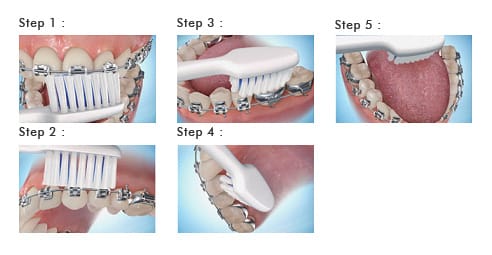
Prepare to brush. Take off elastics, and any other removable parts of your orthodontic appliance.
Clean your braces. Use your brush at a 45-degree angle to clean around the wires and pins of your braces. Brush from the top of each wire and then from the bottom. (Take time to ensure that all plaque and debris are removed, and that you work all the way around upper and lower teeth.)
Brush your teeth. Clean each tooth individually. First, place your brush at a 45-degree angle to the junction between the tooth and the gum, then apply gentle pressure as you move in a circular motion. Do this for about 10 seconds. Use the same brushing action on all outer and inner tooth surfaces, tilting the brush as needed to better reach the insides of smaller front teeth.
Floss once a day with super floss, a type of floss for cleaning around appliances such as braces. Have your dental professional show you how to use this floss, or follow the instructions on the product package.
Rinse and check your teeth. Rinse thoroughly with water or mouth rinse, and examine your teeth and braces in the mirror. They should sparkle, shine and feel clean.
Brush at least four to five times a day following this schedule:
As soon as you wake up, brush really well (at least four minutes). Plaque has had all night to build up on your teeth. Do this before you get dressed or eat breakfast so you won't be rushed.
After breakfast, give a quick brush. This is to remove breakfast from your teeth.
After school, brush really well again. Plaque has been sitting on your teeth since the morning
After dinner, another quickie.
Before you go to bed, scrub 'em good. Now is the time to floss if you want to.
Always remember to not only brush your teeth, but your gums and tongue too!!! Poorly cleaned gums are just as bad as poorly cleaned teeth. They will become puffy, red, and have a tendency to bleed. So, attend to your gums during every brushing session.
The schedule we have suggested takes very little time. Keeping your teeth and gums well cleaned will eliminate bad breath, puffy and unhealthy gums, damage to your teeth, and will speed up the removal of your braces.
Many children and teens (and some adults) don't know how to floss with braces. Or they think that they can't floss at all if they have braces. But that's not the case. In fact, daily flossing is especially important during the time that you wear braces because you're more likely to have food particles trapped in the braces, bands and wires, which could increase your risk of a cavity if the food contains carbohydrates (sugars).
Be prepared to spend three times as long on your oral care while you have braces on your teeth. Don't worry, it's worth the time-if you don't pay attention to oral hygiene while your teeth are being realigned, you increase your risk of gum disease. Plus, it can help your teeth look that much better when it's finally time to get your braces removed.

Although flossing with braces is tricky, you can get the hang of it with practice if you follow these steps:
Use waxed floss (unwaxed floss is more likely to get caught and shred in your braces), dental tape or a product specifically designed to clean around your braces, like the Oral-B® Orthodontic Brush
Use enough. About 18 inches of floss should suffice
Thread it carefully. Take the floss and carefully thread it under the main wire of the braces before passing it between two teeth. Then remove the floss and re-thread it under the main wire to pass between the next pair of teeth
Be sure not to snap the floss-simply move it up and down gently against the side of each tooth
Parents: Do the flossing for younger children who lack the coordination to thread the floss under the main wire of their braces.
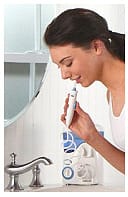
Water Pik, Inc. invented the water flosser (also knows as a dental water jet or oral irrigator) in 1962. For nearly 50 years, we've been a leader in developing and manufacturing innovative personal and oral healthcare products for the entire family.
Our Mission: To be your first choice for innovative, stylish, high-value products that enhance health and wellness while supporting sustainability
We highly recommend using a Waterpik to loosen food particles and plaque before flossing and brushing. Use the Waterpik on the lower water pressure settings so the gum tissue does not become excessively irritated. It is important to note that the use of a Waterpik does not replace the need to brush and floss regularly.
With a strong foundation of innovation, we continually stay in touch with customers to anticipate their needs in product design and health issues. We continue to incorporate the needs of dentists and hygienists in new product designs. As a result, new products continue to reflect higher quality, improved oral health benefits, and greater ease of use.
Gum disease is a serious chronic problem that causes bad breath and tooth loss. Gum disease has also been connected with other systemic diseases such as heart disease, diabetes, and low birth weight babies.
The good news is Waterpik® Water Flossers can help you keep your gums healthy and strong. The Waterpik® Water Flosser is clinically proven to be twice as effective as traditional string floss for improving gum health, plus it's easy and pleasant to use. In just one minute per day, you'll be on your way to excellent oral health and the cleanest, freshest mouth possible.
There will be some foods that are frowned upon and some foods that are completely forbidden. The orthodontist makes these recommendations for a reason. The brackets and wires that are moving your teeth are not invincible. They can be damaged by food. In addition to avoiding foods that might cause damage to your teeth and braces, there are also foods that you will want to eat more often, to enhance the health of your teeth and gums as well as to ease the tension in your mouth as your devices move your teeth around.
Popcorn
Hard candy
Nuts , Peanut brittle
Ice cubes
Candied apples
Hard chips
Chewing gum
Gummy bears
Fruit Roll-ups
Caramels
Taffy
Starburst
Bit-O-Honeys
Milk Duds
Hard French bread - tear into small pieces
Apples - cut into slices instead of biting from
the whole apple
Carrots - grate or cut into tiny pieces
Biting your lip
Biting your fingernails
Chewing on pencils or pens
Pushing your tongue against your teeth
Tearing things with your teeth
Your teeth love vitamin C, calcium and magnesium. The best place to get these vitamins and minerals is from dairy products, leafy greens (though you will want to take care that the greens don’t get stuck in your braces), citrus fruits, brown rice and lentils. Everybody knows that drinking milk makes your bones stronger. It also makes your teeth and gums stronger as well. Make sure to eat a healthy diet that is rich in these vitamins and minerals.
True orthodontic emergencies are very rare, but when they do occur we are available to you. As a general rule, you should call the office when you experience severe pain or when you have a painful appliance problem that you can't take care of yourself. We'll be able to schedule an appointment to resolve the problem. Problems can occur during your orthodontic treatment. You may be able to solve them, temporarily, by yourself until your regularly scheduled appointment.
| Problem | Temporary Solution |
| Loose band or bracket | If still attached to the wire, leave in place. If uncomfortable, place wax on it. |
| Loose Wire | Try to place wire back in place with tweezers. If that is not possible, clip wire behind last tooth to which it is securely attached using clean nail clippers. If uncomfortable, place wax on it. |
| Poking Wire | Try to push sticking wire down with an eraser or spoon. If not possible, place wax on it. |
| Lost Elastic or Metal Tie | Notify us at next appointment. |
| Headgear Does Not Fit | Call office during business hours to schedule an appointment to see the doctor. |
| Soreness | When you get your braces on, you may feel general soreness in your mouth and teeth may be tender to biting pressures for three to five days. Take Advil or Tylenol as prescribed. Warm salt water rinses may help as well. The lips, cheeks and tongue may also become irritated for one to two weeks as they toughen and become accustomed to the surface of the braces |
| Loose Appliances | If sticking or poking into gums, place wax on it. |
If you feel you are unable to handle a problem on your own, please call us as soon as possible. Remember, absolutely no chewing gum, sticky foods or hard foods. Avoid chewing on pens, pencils and fingernails as well.
You have successfully completed the active phase of your orthodontic treatment.
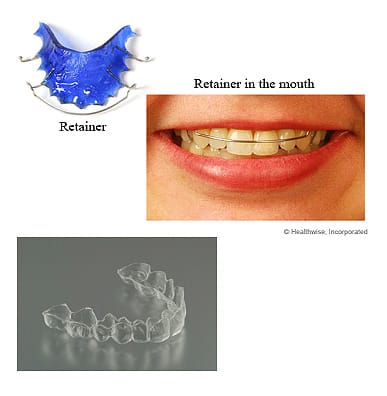
Retention is an essential part of your orthodontic treatment!!! Please pay close attention to the following advice:
Wear your retainers as instructed.
Take your retainers out when eating... but always put retainers in their case (Most appliances are lost in school lunch rooms or restaurants)!
Clean retainers thoroughly once a day by gently brushing with toothpaste and rinsing with warm, not hot, water. Brushing retainers removes the plaque, and eliminates odors. Orthodontic appliance cleaners or denture cleaners can be used, but do not take the place of brushing.
Remove retainers when swimming.
Keep retainers away from hot water, hot car dashboards, pockets, the washing machine, and napkins.
When retainers are not in your mouth they should ALWAYS be in a retainer case. Pets love to chew on them!
Initially, you may find it difficult to speak. Practice speaking, reading, or singing out loud to get used to them.
Retainers are breakable, so treat them with care. If retainers are lost or broken call us immediately.
If you have any questions or concerns about your retainers, or your retainers need adjusting, call us. Do not try to adjust them yourself.
Always bring your retainers to your appointments.
With the proper care your retainers will last for years!
Remember – if you do not wear the retainer as directed your teeth may become crooked again. You may think nothing is happening if you do not wear your retainers, but you will find that by the time you notice, the retainer will no longer fit and nothing can be done to help!